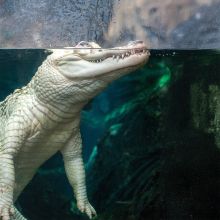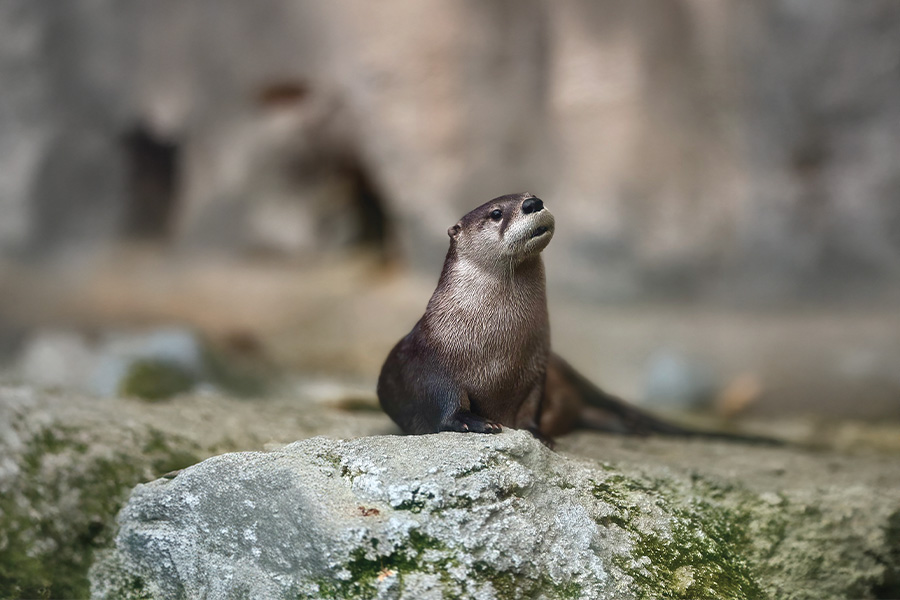
On September 9, 1976, more than 200 people gathered in the scorching sun on the north end of Roanoke Island for the opening of something the Outer Banks had never seen before: an aquarium.
N.C. Governor James Holshouser addressed the crowd, remarking, “Though we’ve conquered outer space, we are continuing to realize that the sea is a source of constant surprise and discovery.”
After the ceremonial ribbon was cut, Roanoke Islanders got their first views of the 13 aquarium habitats, a model of a salt marsh and exhibits on whaling, underwater archaeology, shells and submarines.
Built on land that once belonged to the Etheridge family and later served as a naval base, the new North Carolina Marine Resources Center on Roanoke Island was one of three brand-new aquarium facilities along the North Carolina coast, with sister centers in Pine Knoll Shores and Fort Fisher.
Back then, aquariums were not as ubiquitous as they are today. In establishing three along its coast, North Carolina was ahead of the curve, envisioning that their centers would combine tourism, education and research to inspire visitors while boosting coastal-area economies.
And that is exactly what they have done.

From Humble Beginnings to Coastal Treasures
Over the last 50 years, those modest collections of habitats and exhibits have evolved into grand coastal attractions. Renamed the North Carolina Aquariums in 1986 and expanded and renovated extensively over the years, the three facilities are not just tourist attractions, they are also research, conservation and education mainstays in the state’s three main coastal regions. Jennette’s Pier, a rebuilt version of a historic Nags Head pier that includes aquariums, education and research, joined the three North Carolina Aquariums in 2011.
The North Carolina Aquarium on Roanoke Island is now one of the Outer Banks’ most beloved attractions, welcoming more than 300,000 visitors annually. It has grown from its original 4,000 square feet to 61,000 square feet and houses more than 2,200 animals.
Generations of families have strolled its darkened hallways, pressing their faces up to glass to get an up-close view of snakes, frogs, fish and seahorses and being mesmerized by the jellyfish pulsing in glowing light. In the sky-lit atrium, they have laughed at the playful otters and squatted down to get an underwater perspective of the alligators floating in their swamp, their legs dangling lazily in the murky water. At the 285,000-gallon Graveyard of the Atlantic Ocean habitat — with its replica USS Monitor wreck — millions of visitors have come nose-to-nose with giant sand tiger sharks as they glide by, eyeing the humans with their small dark eyes. And millions of kids have squealed with delight at the touch pools, gently brushing the backs of rays or feeling the armor of a horseshoe crab.

More Than Fish in Habitats
Constant updates, expansions and cutting-edge exhibits have kept the North Carolina Aquarium on Roanoke Island fresh and relevant for more than 50 years.
A major leap forward came in 2014 with the opening of the S.T.A.R. Center, a working sea turtle rescue hospital where guests can peek behind the scenes at sea turtle triage and rehabilitation and see rescued sea turtles in their pools. Young visitors can experience Operation Sea Turtle Rescue by taking a sea turtle replica around to stations to diagnose it, treat it and then return it to the “wild.”
While animal exhibits are a main focus, the aquarium’s magic lies in how it connects people with the ocean, sound, estuaries and natural world. Free daily programs include chatting with a SCUBA diver, educational movies and meeting ambassador animals. Outdoor programs for an additional fee include a Wetlands Walk, fishing, crabbing, paddling in the sound and more. The aquarium’s School’s Out Day Camps and Summer Camps offer young people the chance to interact with animals and nature in exciting ways. The aquarium also participates in a variety of conservation programs that protect the coastal environment and its inhabitants.
It all carries a deeper purpose: to spark wonder, encourage stewardship and inspire visitors to care for the fragile marine environment.

Behind all of this is a team of dedicated staff and volunteers — divers who scrub underwater exhibits, aquarists who feed the fish and animals, veterinarians who nurse sea turtles back to health, exhibit designers who tell stories in fresh ways, educators who lead fascinating programs. The staff is always around to answer any questions guests may have. Their passion is contagious, and it’s part of what keeps visitors coming back year after year.
The 16-acre property offers much more to explore outdoors — a food truck, nature trails, the Pollinator Garden and rain garden and the Soundside Pier, where guests are welcome to enjoy the breezes off the Croatan Sound.
As the North Carolina Aquarium on Roanoke Island celebrates 50 years, it’s clear that it has become more than a tourist stop. It’s a place of discovery, memory-making and connection — a tangible reminder of how the sea shapes our lives on the Outer Banks.
Open daily from 9 a.m. to 5 p.m. except Thanksgiving and Christmas days. The S.T.A.R. Center is open from 9:30 a.m. to 4:30 p.m. daily.
Advanced purchase is highly recommended. Entry is timed, with the last reservation at 4 p.m.
(252) 475-2300
374 Airport Road, Manteo
ncaquariums.com



 Molly Harrison is managing editor at OneBoat, publisher of OuterBanksThisWeek.com. She moved to Nags Head in 1994 and since then has made her living writing articles and creating publications about the people, places and culture of the Outer Banks.
Molly Harrison is managing editor at OneBoat, publisher of OuterBanksThisWeek.com. She moved to Nags Head in 1994 and since then has made her living writing articles and creating publications about the people, places and culture of the Outer Banks.




